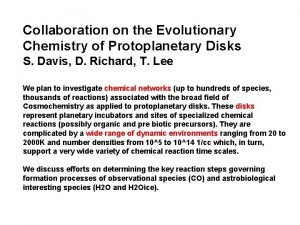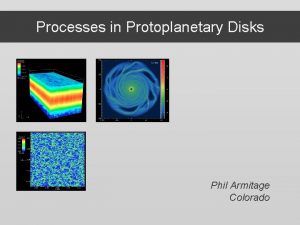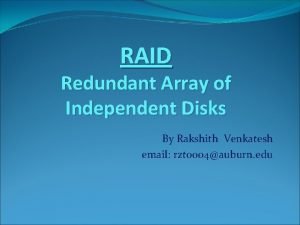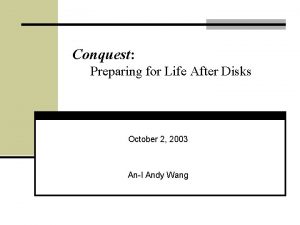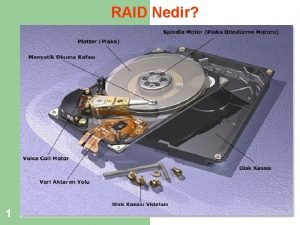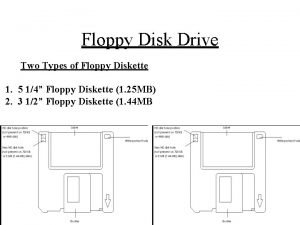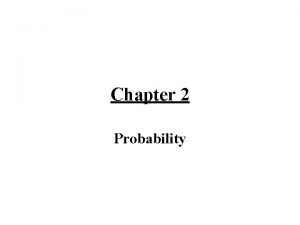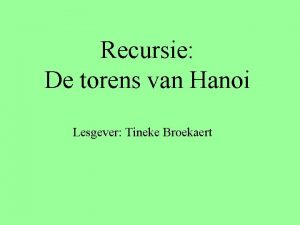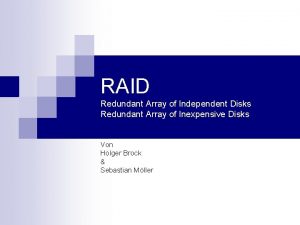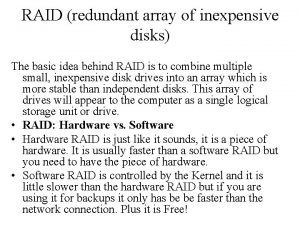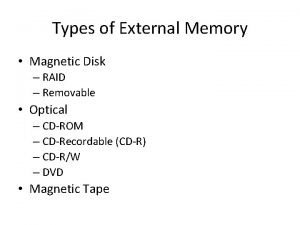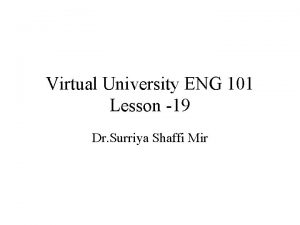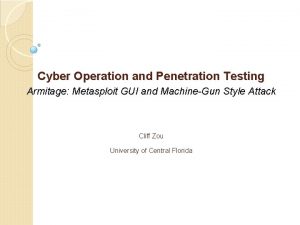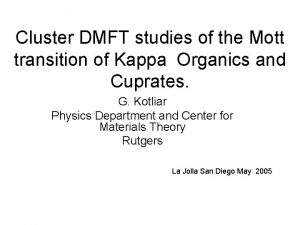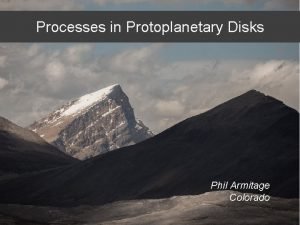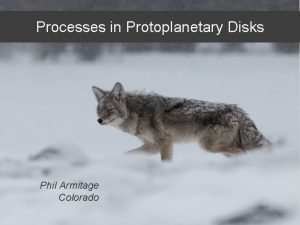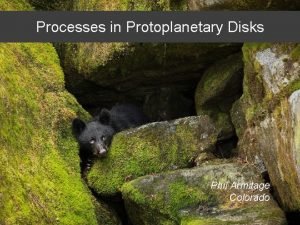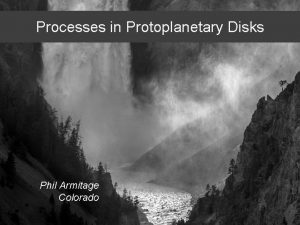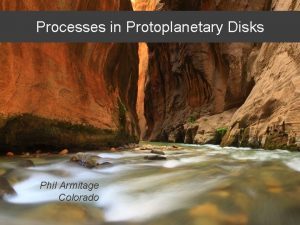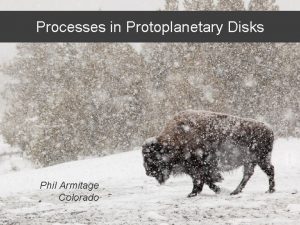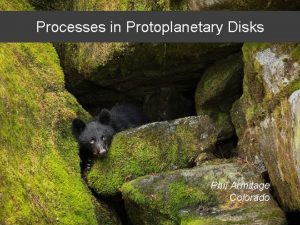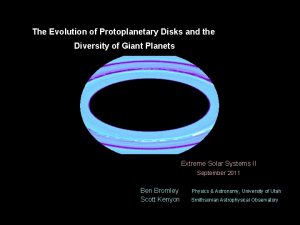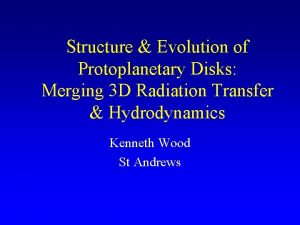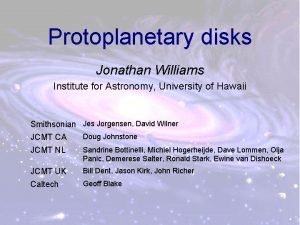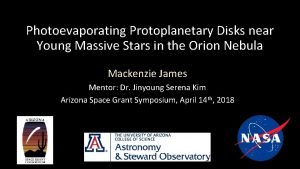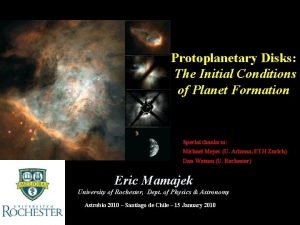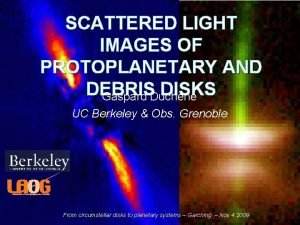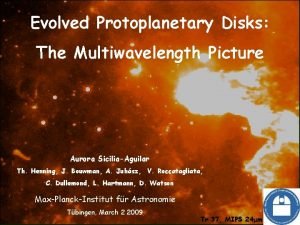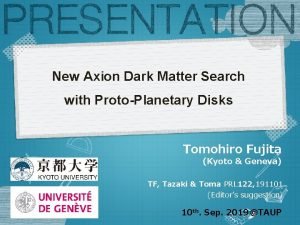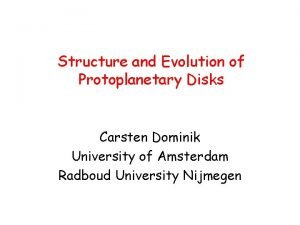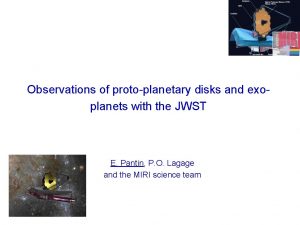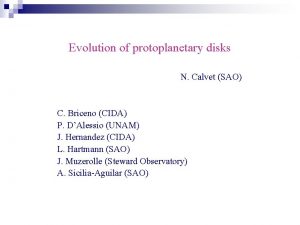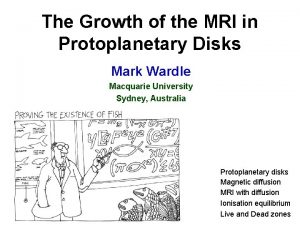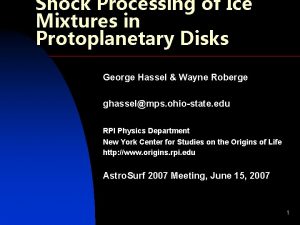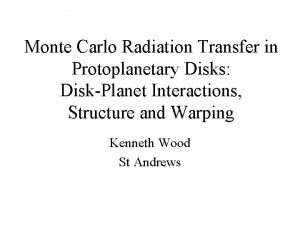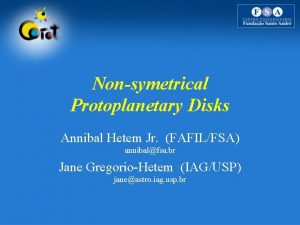Processes in Protoplanetary Disks Phil Armitage Colorado What


























- Slides: 26

Processes in Protoplanetary Disks Phil Armitage Colorado

What can we directly observe? Motivation Limited direct time dependence Dust mm-mm Hartmann & Kenyon ‘ 96 Evolution from population studies HL Tau, ALMA Rosenfeld et al. ‘ 13 Gas – emission & kinematics (CO + other molecules, H 2 hard) Hernandez et al. ‘ 07

What do we aim to learn? Motivation • Why and how disk evolve • Physical conditions for planet formation (density, temperature, level of turbulence…) • Interaction and growth of solids within the gas • Origin of structure within disks • Planet-disk interactions Goal: introduce disk physics that links observations to planet formation IRS 48, van der Marel et al. ‘ 13

Processes in Protoplanetary Disks 1. 2. 3. 4. 5. 6. 7. 8. Disk structure Disk evolution Turbulence Episodic accretion Single particle evolution Ice lines and persistent radial structure Transient structures in disks Disk dispersal

Disk structure Basic principles: disks are long-lived and (usually) well approximated by - • hydrostatic equilibrium • thermal equilibrium • local ionization equilibrium In many cases chemistry is not necessarily in equilibrium

Disk structure Consider a disk: • heated from star (~vertically isothermal) • gas pressure dominated • of low mass compared to star d q r In hydrostatic equilibrium: Write P = rcs 2, for z << r: d. P/dz z Fgrav

Define disk scale height Vertical density profile is gaussian Disk surface density Order of magnitude: at 1 AU, S ~ 103 g cm-2, h / r ~ 0. 03 r 0 = 10 -9 g cm-3 cs = 105 cm s-1 (1 km s-1) mean free path l ~ cm

What could alter vertical density profile? • self-gravity, condition is roughly • magnetic pressure B 2 / 8 p z ~ 4 h Hirose & Turner ‘ 11 find magnetic support above about z ~ 4 h, leading to an exponential atmosphere (1 AU, flux-limited diffusion) Depends on MHD processes in disk, in some cases B(z) may have larger effect

Velocity structure gravity rotation pressure gradient For a slowly evolving disk, in axisymmetry: P = rcs 2, and cs ~ h, so 2 nd term O(h/r)2

A specific example: S ~ r-1, Tc ~ r-1/2 At 1 AU, if (h/r) = 0. 03: • gas is sub-Keplerian by ~0. 25% • |vf – v. K| ~ 70 ms-1 Non-self-gravitating disks can be treated as Keplerian for all practical (gas dynamical) purposes Small deviation has outsized importance for particle dynamics!

At same order (h/r)2 there is vertical shear in the equilibrium velocity field, even if disk is vertically isothermal • see Takeuchi & Lin ’ 02 for calculation • Rosenfeld et al. ’ 13 – effects at this order are potentially observable in molecular line kinematics

Temperature Stellar irradiation vs heating by accretion Globally, accretion dominates if: Both heating sources can matter – depends on accretion rate, stellar mass, radius…

• starlight heats dust • optically thin dust emits IR • optically thick dust emits warm dust longer l IR emission • dust & gas exchange energy • gas cools stellar photons l ~ 1 mm line emission from gas dust photo-electric heating (UV) gas-dust collisions optically thick disk emission

Simple limit: razor-thin, optically thick disk, intercepts star light and re-emits locally as blackbody emission Evaluates exactly to: Asymptotically (r >> R*) …disks usually flare to large distances

Additional physics for dust emission 1) Disk flares, intercepts more flux at large r than flat disk (Kenyon & Hartmann 1987) 2) Surface dust radiates inefficiently (size smaller than the wavelength of re-emitted IR radiation) thermal equilibrium for dust, radius s absorption re-radiation emissivity, with b ~ 1 warm optically thin emission from surface dust layer

Approximate analytic models: 50% of disk L in blackbody interior emission 50% in emission from a warmer surface dust layer Chiang & Goldreich ’ 97 – S = 103 (r / AU)-3/2 g cm-2, M = 0. 5 MSun, T = 4000 K, R* = 2. 5 RSun Garaud & Lin ‘ 07 for version including accretion heating Passive disks have T ~ r -0. 5, flare to large r, any contribution from accretion heating greater at small r

What about the gas temperature? Heating • collisions between molecules and dust particles - efficient equilibration at high density: Tgas = Tdust • photoelectric heating near surface UV photon, E = 10 e. V 90% of time: energy thermalized in grain 10% of time: eject an electron into gas electron: Ee = EUV – w ~ 5 e. V ~5% of incident UV flux goes into gas heating Cooling – rotational transitions (e. g. CO), atomic fine structure lines

Henning & Semenov ‘ 13, from Akimkin et al. ‘ 13 General structure: • optically thick, vertically isothermal structure near disk mid-plane • warmer dust at surface • still warmer molecular layer of gas Need numerical codes to compute gas + dust models

Ionization fraction xe = ne / n. H affects: • chemistry • coupling of gas to magnetic fields Ionization Thermal ionization Gas becomes fully ionized only at T ~ 104 K These temperatures attained only in very high accretion rate states Change in opacity when H is ionized is important for episodic accretion models ionization of hydrogen (opacity from Semenov et al. ‘ 03)

Thermal ionization Ionization of the alkali metals occurs at T ~ 103 K Yields an electron fraction xe ~ 10 -12 Very low ionization degree, but comparable to the ionization needed to couple magnetic fields to gas Calculation: use Saha equation, answer just f(T, r)

Non-thermal ionization – this is much nastier! Need to know and balance: • explicit ionization rates z from non-thermal processes • specific reactions that lead to recombination e. g. if dominant reaction is recombination with molecular ions (“dissociative recombination”), such as e- + HCO+ rate equation H + CO in ionization equilibrium neutrals Solution assuming overall neutrality rate coefficient (function of T)

Non-thermal ionization far-UV photons, ionize C, S etc to depth of 0. 01 to 0. 1 g cm-2 column stellar X-rays (5 ke. V), stopping depth 5 -10 g cm-2 unshielded cosmic rays, stopping depth ~100 g cm-2 radioactive decay 26 Al normally dominant

Simplified model for ionization rates after Turner & Sano ‘ 08 Mid-plane of the inner disk is too cold to be thermally ionized, dense enough to be shielded from external sources of ionizing radiation… very low xe

Stellar X-ray ionization from Ercolano & Glassgold ‘ 13

Calculation of ionization fraction from Ilgner & Nelson ‘ 06 Metal ions and dust grain reactions are both important factors determining ionization degree

Are cosmic rays shielded from disk? Solar wind modulates local flux of cosmic rays, do T Tauri stellar or disk winds have similar effect? (Cleeves et al. ‘ 13) Is the microphysics of ionization balance fully understood? Ionization by electrons accelerated in MHD turbulence, non-linear relation between current and electric field strength… (Inutsuka & Sano ’ 05; Okuzumi & Inutsuka ‘ 15)
 Protoplanetary disk
Protoplanetary disk Disk structure
Disk structure Concurrent processes are processes that
Concurrent processes are processes that Redundant arrays of independent disks
Redundant arrays of independent disks Conquest data disks
Conquest data disks Redundant nedir
Redundant nedir Floppy disk
Floppy disk Probability learning objectives
Probability learning objectives Tower of hanoi 4 disks
Tower of hanoi 4 disks Redundant array of independent disks
Redundant array of independent disks Which of the following are magnetic storage devices
Which of the following are magnetic storage devices Aka.ms/sqlcapacity
Aka.ms/sqlcapacity Redundant arrays of inexpensive disks
Redundant arrays of inexpensive disks Types of magnetic disks
Types of magnetic disks Disks and tapes can be stored ------- a library. eng101
Disks and tapes can be stored ------- a library. eng101 Computer parts labeling
Computer parts labeling Suman armitage
Suman armitage Armitage linux
Armitage linux Kid simon armitage
Kid simon armitage Sn1per metasploit
Sn1per metasploit The clown punk poem
The clown punk poem His bloody life in my bloody hands
His bloody life in my bloody hands Manhunt simon armitage
Manhunt simon armitage Hitcher simon armitage
Hitcher simon armitage The manhunt simon armitage analysis
The manhunt simon armitage analysis Armitage
Armitage Clown punk poem
Clown punk poem
